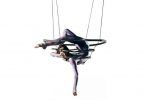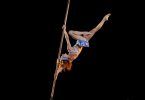Aerial yoga has become a popular workout and relaxation practice, offering numerous physical and mental benefits. However, like any physical activity, many wonder, is aerial yoga dangerous? As with any physical practice, there are certain considerations and precautions to keep in mind, especially for individuals with specific health conditions or physical limitations. This guide consolidates everything you need to know about aerial yoga, from its benefits and safety tips to who should approach it with caution.
What Is Aerial Yoga?
Aerial yoga, also known as anti-gravity yoga, combines traditional yoga poses, Pilates, and aerial acrobatics using a fabric hammock suspended from the ceiling. This innovative practice not only challenges the body but also promotes mental focus and creativity. The hammock provides support for deeper stretches, inversions, and movements that are difficult to achieve on the mat.
Who Should Not Do Aerial Yoga?
Before taking flight in the hammock, it’s essential to understand who should exercise caution or avoid aerial yoga altogether due to certain health conditions or physical limitations. Understanding whether aerial yoga is dangerous requires knowing the risks involved.
1. Pregnant women
Pregnancy is a beautiful and delicate phase in a woman’s life, and while staying active is generally encouraged, aerial yoga might not be the best option during this time. The dynamic movements and inversions involved in aerial yoga can put a strain on the abdominal muscles and may not be safe for both the mother and the baby. Opting for prenatal yoga or other gentle exercises that are specifically designed for pregnant women is a better choice during pregnancy.
2. People with certain medical conditions
If you have a heart condition, high blood pressure, glaucoma, or any other medical condition that might be exacerbated by hanging upside down or experiencing sudden changes in blood flow, aerial yoga may not be suitable for you. These conditions can increase the risk of injury or complications during the practice. Always consult with your healthcare provider before attempting any new physical activity, especially if you have pre-existing health issues.
3. Individuals with recent surgeries or injuries
If you’re recovering from a recent surgery or have an injury that hasn’t fully healed, aerial yoga could hinder the healing process and potentially lead to further complications. Participating in any physically demanding activity before you have fully recovered may put undue stress on your body and delay the healing process. Listen to your body and allow it the time it needs to heal completely before attempting it.
4. Those with vertigo or inner ear disorders
Aerial yoga often involves inversions and flipping upside down, which can trigger dizziness and disorientation in individuals with vertigo or inner ear disorders. Such conditions may not only affect your ability to perform the poses safely but also diminish your overall enjoyment of the practice. If you have vertigo or any issues related to balance, it’s best to avoid it or seek guidance from a healthcare professional before trying it.
If you’re facing issues related to balance, such as vertigo or inner ear disorders, you might be curious about the different options available in aerial arts. Our article Aerial Silks vs. Aerial Sling: What’s the Difference and Which One is Right for You? provides a detailed comparison between aerial silks and aerial slings, helping you make an informed choice based on your specific circumstances.
5. Individuals with a fear of heights or enclosed spaces
While it might seem obvious, aerial yoga involves being suspended in the air, which could be unsettling for individuals with acrophobia (fear of heights) or claustrophobia (fear of enclosed spaces). These fears can interfere with your ability to relax and fully engage in the practice. If you experience intense fear in these situations, it’s advisable to explore other forms of yoga that keep you grounded and in open spaces.
6. People with severe joint issues
Aerial yoga can be physically demanding, and individuals with severe joint issues, such as arthritis, might find some poses uncomfortable or challenging. Putting additional stress on compromised joints can worsen the condition and lead to injuries. Opt for yoga practices that are more gentle on the joints, like restorative yoga or chair yoga, to maintain flexibility and improve mobility. If you’re dealing with severe joint issues, you may also want to consider the differences between aerial yoga hammocks and aerial slings. Understanding the unique features of each option can help you make an informed decision about which aerial practice is more suitable for your needs. Check out our article “Differences Between Aerial Yoga Hammock and Aerial Sling: Choosing Your Aerial Journey” for more insights.”
7. Children without proper supervision
Aerial yoga can be enjoyable for children, but it’s essential that they are supervised by trained instructors who can ensure their safety at all times. Children may be tempted to try advanced moves without proper guidance, leading to potential accidents or injuries. If you’re considering aerial yoga for your child, enroll them in a kids’ class where instructors can provide age-appropriate instruction and support. For those interested in starting their aerial arts journey, our article Aerial Sling: The Perfect Starting Point for Aerial Arts offers valuable insights into the benefits of aerial sling practice.
Is Aerial Yoga Dangerous?
When practiced correctly, aerial yoga is generally safe. However, following these precautions ensures a secure experience:
- Choose Qualified Instructors
- A certified aerial yoga teacher ensures proper guidance and minimizes risks.
- Use High-Quality Equipment
- Check for securely anchored hammocks and perform regular inspections for wear and tear.
- Gradual Progression
- Start with foundational poses and build strength before attempting advanced moves.
- Listen to Your Body
- Avoid pushing through pain or discomfort during poses.
- Maintain Proper Alignment
- Engage core muscles and focus on body positioning to avoid strain or injury.
Benefits of Aerial Yoga
Aerial yoga offers a unique combination of physical and mental benefits:
- Improved Flexibility: The hammock assists in achieving deeper stretches.
- Spinal Decompression: Inversions relieve pressure on the spine.
- Core Strengthening: Constant stabilization builds a stronger core.
- Stress Relief: Mindful movements and the sensation of weightlessness reduce anxiety.
- Enhanced Balance: The dynamic nature of aerial yoga improves coordination.
- Creativity and Fun: Exploring new poses brings a playful element to fitness.
Tips for a Safe and Enjoyable Practice
- Dress Appropriately
- Wear fitted clothing without zippers or buttons to prevent snagging on the hammock.
- Avoid Heavy Meals Before Class
- Eat light to avoid discomfort during inversions.
- Stay Hydrated
- Bring water to stay refreshed during and after practice.
- Practice Self-Awareness
- Be mindful of your limits and adjust poses as needed.
Is Aerial Yoga Dangerous? Conclusion
Aerial yoga is a dynamic and rewarding practice that blends fitness, mindfulness, and creativity. While it’s accessible to many, it’s essential to prioritize safety, listen to your body, and seek guidance from qualified instructors. For those who may not be suited for aerial yoga, there are plenty of alternative fitness options to explore.
Whether you’re taking your first flight or looking to refine your skills, aerial yoga can elevate your well-being—literally and figuratively.
Remember, the decision to try it should be based on your individual health and comfort level. If you fall into any of these categories, don’t worry – there are plenty of other fantastic fitness activities and yoga styles that can help you stay active and healthy. Always prioritize safety and consult with a healthcare professional if you have any concerns about starting aerial yoga.







